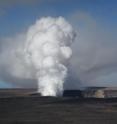Mounting research shows increased health risks from volcanic air pollution
Kilauea Volcano on Hawaii's big island has been erupting on its east rift since 1983. But, in March 2008, an additional eruption vent opened at the volcano's summit, resulting in about triple the amount of sulfur dioxide gas (SO2) emissions drifting to the local community of Ka'u, raising health concerns over the risks associated with exposure to "vog," as the islanders refer to this volcanic air pollution. A University of Nevada, Reno researcher seized the opportunity to build upon her previous research of health risks associated with exposure to vog. Bernadette Longo, assistant professor at the University's Orvis School of Nursing, embarked on a study to compare local health clinic records for the 14 weeks prior to the March 2008 eruption on the summit, to the health clinic records March through June 2008, when the volcano's SO2 emissions tripled.
Her team's research, published in an article in the Journal of Toxicology and Environmental Health last month, found that the clinic saw three times as many headaches and twice as many severe sore throats after the increase in volcanic emissions. In addition, there was a 56 percent increase in cough, and a six-fold increase in the odds of having acute airway problems – more serious respiratory problems usually requiring immediate breathing treatments or transfer to the nearest hospital for emergency care.
"The results suggest that children and adolescents are likely to be the most sensitive to SO2 exposure, which is especially concerning," Longo said. "Children tend to be mouth-breathers. When we breathe through our noses, our noses act as filters, removing about 85 percent of the harmful substances before they can reach our respiratory system and lungs," she explained. "But, when children breathe mostly through their mouths, they don't get the benefit of the nose's filtering system."
Longo said that in addition to children, the elderly, smokers and those with existing conditions such as asthma and emphysema are also especially at risk. She has been conducting research on vog for eight years and has identified those exposed to Kilauea's vog are at greater risk of developing acute bronchitis than those not exposed to vog.
Longo also conducted studies published earlier this year in a Family and Community Health article, showing that a large percentage of the SO2 was penetrating indoors, into the Ka'u schools and hospital, especially when air conditioning wasn't installed or in use and windows were left open. As a result, the area's schools have installed air conditioners and the hospital's ventilation system has been improved, with more improvements planned as funding becomes available.
This past summer, Longo worked with local health-care agencies and emergency-room doctors to help provide education to the community about using air conditioners if they have them, closing windows and avoiding outdoor activity during the times of heaviest exposure, 7 p.m. to 10 a.m., each day.
"It is fairly safe for schoolchildren and residents to exercise, go fishing or play outside in the afternoons, when the trade winds keep the vog out of the area," Longo said. "If people take the necessary precautions, they can lower the health risks posed by the vog, and ultimately, that is the purpose of our research," she said.
Collaborating on the most recent study with Longo was her Nevada colleague, Wei Yang, professor of epidemiology and biostatistics; Dr. Joshua B. Green from the Ka'u Hospital and Rural Health Care Clinic; and advanced practice nurses Frederick and Vickie Crosby, from the Ocean View Family Health Clinic.
Dr. Green, also a Hawaii State Senator, said that as a result of the studies, they've been able to get more doctors and nurses into the area to provide care. He says he will continue to use the research findings to garner additional support to study the effects of vog and minimize its health impacts on the island's population.
"The research has spurred quite a lot of conversation at the Department of Health, and there was a special task force created in the House of Representatives to study it," he said. "This research will help some of those recommendations to be implemented. It's very important that we have scientific assessment of the effects of the vog. We need to continue this work in the years to come to see what the long-term effects are on our people."
Source: University of Nevada, Reno
Articles on the same topic
- Air pollution exposure increases risk of severe COPDTue, 19 Oct 2010, 17:04:00 UTC
Other sources
- Mounting research shows increased health risks from volcanic air pollutionfrom Science DailyWed, 20 Oct 2010, 15:30:24 UTC
- Mounting research shows increased health risks from volcanic air pollutionfrom PhysorgWed, 20 Oct 2010, 13:30:51 UTC
- Mounting research shows increased health risks from volcanic air pollutionfrom Science BlogWed, 20 Oct 2010, 13:30:23 UTC
- Air pollution exposure increases risk of severe COPDfrom PhysorgTue, 19 Oct 2010, 17:02:03 UTC
